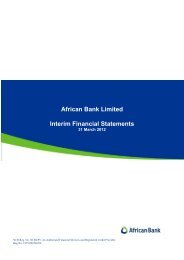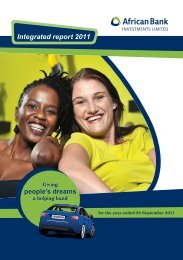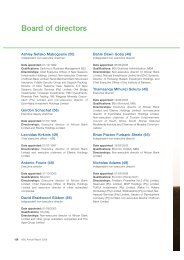Download - African Bank
Download - African Bank
Download - African Bank
Create successful ePaper yourself
Turn your PDF publications into a flip-book with our unique Google optimized e-Paper software.
Credit risk<br />
<strong>African</strong> <strong>Bank</strong> Retail<br />
Credit decisions are made using a<br />
combination of manual and automated<br />
processes based on rigorous analysis<br />
of historical performance. The risk tools<br />
involve a series of scorecards and<br />
discrete criteria derived from data<br />
sources such as credit bureaux, pay<br />
slips, bank statements and information<br />
obtained during the client interview<br />
stage. These sources enable<br />
determination of a true financial picture<br />
for each client. Centrally, payroll loans<br />
also undergo further scrutiny at the<br />
employer level to account for economic<br />
trends in the relevant industry sectors<br />
and the employment stability of<br />
employees. Credit criteria determine<br />
the final product offering ie. loan size,<br />
term and price and are based on the<br />
individual’s risk assessment.<br />
The underwriting principles are<br />
predicated on establishing the ability,<br />
stability, and willingness to pay and are<br />
captured in the following manner:<br />
Ability to pay<br />
– Application data supplemented<br />
with pay slips, bank statements<br />
and bureaux enquiries to<br />
establish the client’s debt burden<br />
and affordability.<br />
Stability<br />
– Clients must be formally<br />
employed for minimum periods<br />
of time and employment is<br />
verified with employer.<br />
Willingness to pay<br />
– Repayment for retail loans is<br />
automated according to the pay<br />
frequency of the client and<br />
deducted from his/her bank<br />
account. For payroll loans, the<br />
employer deducts payment at<br />
source.<br />
– The client’s credit bureau history<br />
enables assessment of<br />
willingness to pay for new loans.<br />
For those clients with existing<br />
loans or prior history, actual loan<br />
performance is leveraged in this<br />
assessment.<br />
In addition to the rigorous credit<br />
decision making procedures, the division<br />
monitors and controls risk through a<br />
number of mechanisms:<br />
Detailed MIS on the application<br />
process and loan performance to<br />
enable timely identification and<br />
assessment of potential problem areas;<br />
Sophisticated data mining and<br />
multivariate analysis to identify and<br />
capitalise on behavioural patterns<br />
and trends;<br />
Limitation of exposure for specific<br />
corporate payrolls based on<br />
historical performance;<br />
System-enforced data quality rules<br />
and logic to ensure clean capture of<br />
application data and adherence to<br />
credit policy;<br />
Fraud detection systems with<br />
dedicated resources for analysis and<br />
follow-up;<br />
Electronic disbursement of all loans;<br />
Exception reporting to control fraud<br />
and identify errors.<br />
Collections<br />
The Collections business unit is<br />
responsible for the collection of all<br />
<strong>African</strong> <strong>Bank</strong> Retail matters from the<br />
date of default until the loan repayments<br />
are either rehabilitated or the loan is<br />
written off.<br />
Risk management within the<br />
Collections business unit is achieved<br />
through a combination of advanced<br />
technology and dividing the unit into<br />
smaller areas of focus.<br />
In terms of technology, a substantial<br />
investment in the collections<br />
environment has been made over the<br />
past 18 months. The main elements are:<br />
A fully integrated, specialist<br />
collections software package called<br />
Tallyman. The key features of this<br />
package are, amongst others,<br />
workflow automation, document<br />
generation, work prioritisation and<br />
queueing and the ability to set<br />
collection strategies at client level for<br />
clients with multiple loans;<br />
The call centre technology has been<br />
upgraded with the acquisition of<br />
additional predictive dialling<br />
capacity, the implementation of a<br />
new PABX together with its<br />
integrated call centre management<br />
system. The process of integrating<br />
the client services call centre, which<br />
deals with inbound calls, is also in<br />
progress and specialised workflow<br />
technology to automate much of this<br />
process has been acquired.<br />
The principle of specialised focus to<br />
enhance risk management, which is<br />
practiced throughout the organisation, is<br />
also applied in the Collections business<br />
unit. The unit is divided in the following<br />
four divisions with special focus on:<br />
Legal Collections;<br />
Administration Orders;<br />
Call Centre; and<br />
Insurance.<br />
Each division has an executive<br />
responsible for its specific risks,<br />
objectives and results and is divided into<br />
further specialist units as required.<br />
In respect of general process, once<br />
a loan is identified as being in default<br />
it is immediately transferred to the<br />
call centre. Arrangements to collect<br />
the overdue instalments are made<br />
with the debtor, and, in the event of<br />
such attempts being unsuccessful the<br />
debtor is progressed through the various<br />
stages of legal collection. In the event<br />
of non-performing loans being identified<br />
either as insurance claims or<br />
administration order matters, the loans<br />
are transferred to the appropriate<br />
division for recovery.<br />
The ultimate risk mitigator within the<br />
Collections business unit is having<br />
experienced, appropriately qualified<br />
staff. The Collections business unit is<br />
well equipped at all staff levels, but<br />
in particular at senior and middle<br />
management to handle the current<br />
risks. This favourable situation has<br />
arisen both through experience gained<br />
within the bank, as well as the<br />
opportunity to acquire and retain<br />
collection skills through the Saambou<br />
transaction.<br />
Credit Indemnity<br />
The division is continuing to grant new<br />
credit using a dual score matrix which<br />
combines an internal score with a credit<br />
bureau score when assessing first time<br />
65<br />
<strong>African</strong> <strong>Bank</strong> Investments Limited







